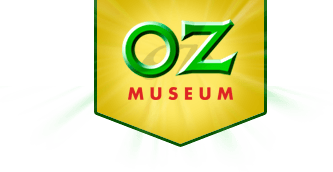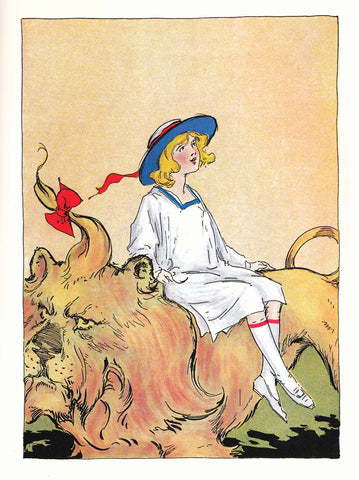 VISIT
MUSEUM STORE
MEMBERSHIP
OZ NEWS
CONTACT
VISIT
MUSEUM STORE
MEMBERSHIP
OZ NEWS
CONTACT
DISCOVERING OZ: THE ROYAL HISTORIES! - THE WIZARD RETURNS...

[Above: This is one of the sixteen color paintings done by John R. Neill to augment his superlative black-and-white line work for DOROTHY AND THE WIZARD IN OZ. It depicts a moment that has always resonated with Oz fans, as Princess Ozma welcomes Ms. Gale of Kansas back to the Emerald City.]
By now, it’s safe (and only fair) to say that the question at the end of last month’s Blog was -- for sure – rhetorical. There’ll thus be no further suspense: Dorothy Gale of “Uncle Henry’s Farm near Topeka” did, indeed, return to the Land of Oz from the United States for additional visits. 😊
L. Frank Baum’s third Oz book, OZMA OF OZ, sold so well upon publication in 1907 that he didn’t hesitate to produce a fourth and fifth title for the series in 1908 and 1909. His income from Oz sales was gratifying; his pleasure with his publishers, The Reilly & Britton Co., was undeniable; and he continued to receive literally thousands of letters from readers of all ages. Among these communications, the children’s unbridled enthusiasm for Dorothy was paramount. Beyond that, however, many were also now wondering about the fate of “the little Wizard,” as nothing had been heard about him since he departed the Emerald City in a balloon near the conclusion of the first Oz story, THE WIZARD OF OZ.
Fortunately for Baum in 1908, the latest news he received and shared from Oz realigned both of those characters. Dorothy continued to be the poster child for the “survival-of-natural-disasters,” having previously traveled over-the-rainbow via cyclonic tornado (or tornadic cyclone) and as an “overboard!” victim of stormy oceanic caprice. In DOROTHY AND THE WIZARD IN OZ, the author explains that she and her kitten, Eureka – along with Dorothy’s cousin, Zeb, and a long-in-the-tooth cab horse, Jim (plus his buggy) – have fallen prey to a violent earthquake, tumbling into a huge crack in the California landscape. They drop down until they reach an underground kingdom of emotionless vegetable people, the Mangaboos -- and Dorothy’s arrival with her companions is soon followed by that of the former Wizard of Oz, whose balloon and basket descend into the earth in similar fashion.

[Above: John R. Neill pictures the reunion of two beloved friends.]
The story that follows is more an action/adventure tale than a sunshine-and-shadow Ozzy saga. Our five protagonists (along with the Wizard’s “Nine Tiny Piglets”) are seldom out of danger for the next seventeen chapters. The Mangaboos want to toss them into a Black Pit -- or the Garden of the Twining Vines, where they’ll be crushed to death. Even when Dot & Co. ultimately escape, they’re confronted by ravenous invisible bears, and destruction next looms for the travelers in a confrontation with the violent, all-wooden Gargoyles in their all-wooden kingdom. Another successful getaway leads only to full confrontation with a sanguine and welcoming den of dragonettes, who can’t wait to further appreciate the party at mealtime.

[Above: Their Dragon mother (approximately two thousand years old) has gone above ground to find food for her offspring (who are only sixty-six years of age). The children – several of whom are seen here -- would have doubtless enjoyed feasting on the Wizard, Dorothy, Zeb, and others in their party. Fortunately for our friends, however, “Mrs. Dragon” has tied all the tails of her young(ish) brood around the rocks at the back of their individual caves, which means they’re incapable of crawling out to make hash of the unexpected visitors from the United States. Original color painting by John R. Neill.]
Even Baum’s lighter moments in DOROTHY AND THE WIZARD IN OZ are tinged with surprise. The pleasant -- if briefly-faced -- folk encountered in the Valley of Voe are ultimately “UNfaceable” in that they’re also completely invisible. (The next-met Braided Man is just plain looney.) Then, when trapped in a dead-end cavern and all seems lost, Dorothy remembers to make a hand signal that she knows will be seen by Princess Ozma in the nearby Land of Oz. In an eye-blink or two, our friends find themselves in the Emerald City, and there is a happy reunion. Best of all, the Princess offers the Wizard a permanent home, which the aged gentleman is delighted to accept. Even thereafter, however, there are troubles: Eureka faces trial after being accused of eating one of the Wizard’s diminutive porkers, and Jim the Cab Horse feels shame when he’s beaten in a race by Ozma’s indefatigable prize steed, the wooden Sawhorse.


[Above, top: Shown here are two of the more challenging encounters faced by our old friend, the Wizard, in his journey back to Oz. When Gwig, sorcerer of the Mangaboos, manages to increasingly stifle his breathing, the Omaha native saves himself by cutting the villain in half. As Gwig is one of the Vegetable People, the end result is no messier than would be the results of slicing into two halves a ginormous cold potato. Just above: Later on in the story, the Wizard leads the battle against the Wooden Gargoyles; both paintings are the work of John R. Neill.]
If not nearly as perky and pleasant as most of Baum’s other Oz stories, DOROTHY AND THE WIZARD IN OZ offers a splendidly exciting escapade of jeopardy and risk, tied together with the author’s recurring themes of bonding friendship and teamwork. The book was also immeasurably enhanced by the art of John R. Neill, who – after two preceding Oz Books – hit his stride here in numerous excellent line drawings and sixteen color paintings, adapted for the glossy full-page plates.

[Above: This contemporary advertisement for Reilly & Britton’s 1908 output is primarily a Baumian herald. In addition to DOROTHY AND THE WIZARD IN OZ, Frank was also writing as “Edith Van Dyne” for the three AUNT JANE’S NIECES titles and as FLOYD AKERS for the three BOY FORTUNE HUNTER titles. Further: John R. Neill was the illustrator of CHILDREN’S STORIES THAT NEVER GROW OLD.]
Critics were once again exultant. The Duluth NEWS-TRIBUNE praised, “Another Oz book is always hailed by the juvenile readers as a source of much delight . . . [This] new and startling series of adventures [has] the same old trick of making us ‘wish for more’ when the last chapter is finished.” The Portland OREGONIAN willingly concurred: “Every line of the book entertains . . . Fun? Any amount of it . . . There’s only one Oz.”

[Above: In 1949 – possibly in conjunction with the first theatrical rerelease of Metro-Goldwyn-Mayer’s 1939 THE WIZARD OF OZ motion picture – Capitol Records released an audio adaptation of Baum’s fourth Oz story. The three-disc 78rpm set was later acclaimed by freelance writer and children’s record specialist Gregory H. Ehrbar as “exuberant and amusing – the kind of recording that gets better upon repeated listenings.”]
The rapturous reception accorded DOROTHY AND THE WIZARD IN OZ propelled Baum into volume five of what was by now a firmly established series. If you’ll recall from last month’s Blog, he’d promised Reilly & Britton two additional Oz books sometime between 1906-1910. Instead, there’d been Oz tales, including the return of Dorothy in both 1907 and 1908, and he quickly moved on to THE ROAD TO OZ for 1909.

[Above: In conjunction with the release of the 1939 MGM movie musical of THE WIZARD OF OZ, this “junior edition” of THE ROAD TO OZ was one of nine small Oz storybooks issued by Rand McNally & Company in a “special arrangement with” Reilly & Lee (as that company was by then known) and Baum’s widow, Maud Gage. You’ll read below that the Reilly & Lee editions of THE ROAD TO OZ never included color artwork, so Rand McNally had several Neill illustrations colorized for their abridgement. His original dust jacket cover art -- which HAD been in color -- was completely redrawn (if copied) for Rand McNally’s use. Neill’s own dust jacket drawing may be seen below, near the conclusion of this Blog.]
I’ve written in the past about my affection for THE ROAD TO OZ. It was the second Oz Book I read; I only knew about THE WIZARD OF OZ before stumbling on to THE ROAD – literally and figuratively – at Gimbels Department Store in downtown Milwaukee, Wisconsin, in 1958. Some months later, it was my eighth birthday gift and proved to be, for me, the perfect continuation of the Oz narrative. As in THE WIZARD, Dorothy and Toto set out from Kansas, ultimately traveling with three companions through a half-dozen demanding or intriguing challenges before reaching the Emerald City. Her chums – all new to Baum’s writings – were the Shaggy Man (a raggedy but harmless and helpful hobo-on-the prairie-highway who meets the girl when passing the Gales’ Kansas farmhouse); Button-Bright (a very young, guileless, and lost little boy); and Polychrome, the Rainbow’s Daughter. Her full name here explains everything you need to know about one of Baum’s most beautiful and fantastic fantasy figures. All three characters quickly became popular with Oz readers and appear again in multiple later books (whether in roles that are plot active or plot adjacent).



[Top: Polychrome dances into fairy tale history in THE ROAD TO OZ and immediately becomes an unforgettable presence in her every subsequent Oz Book appearance. Middle: Little Button-Bright gleefully meets Dorothy’s old cohort, Tik-Tok the Machine Man, and can’t wait to wind up his clockwork. Just above: Courtesy Princess Ozma, the Shaggy Man is able to discard his dusty road wear when arriving in the Emerald City, yet – thanks to the ever-thoughtful Oz sovereign – he is able deck himself out in equally shabby but elegant velvet and satin instead. The top and bottom drawings are the Rand McNally “colorized Neill” images of 1939; the black-and-white Neill comes from the original 1909 edition of THE ROAD TO OZ.]
The initial journey taken by Dorothy, Toto, and their new associates in THE ROAD TO OZ is beset with complications. The Shaggy Man is given the head of a donkey and Button-Bright the head of a fox by well-intentioned but semi-clueless kings whom they meet during the trek. A few chapters later, the Oz-bound company is masterfully saved from immediate destruction on the Deadly Desert, but only thanks to the intervention of Shaggy’s compatriot, the magical Johnny Dooit. As can be seen below, the latter builds them a sailboat/sand boat to cross the poisonous dunes. Note that Poly, out at the front of the ship, has forsaken the rainbow for a plain bow (if differently pronounced). To her left are Dorothy, the donkey ears of Shaggy, and the gray fox ears and wide eyes of Master Bright:

And only Shaggy’s pitching arm saves our principals (and Toto, too) from becoming soup in the hands and kettle of the carnivorous Scoodlers. Please see below. (Side note: For me, the Scoodler sequence marks one of the most happily harrowing situations in all of Baum’s Oz work. If you can regress to your young and considerably preteen self, ya gotta read it!)

Not surprisingly, all ends extremely well; it turns out that the entire jaunt was conceived by Princess Ozma. It was she who scrambled the pathways near the Gales’ Kansas farm so as to send Dorothy, Toto, and Shaggy down THE ROAD TO OZ. And not unreasonably so: the Princess wants her Kansas colleague to attend the massively royal celebration of Ozma’s birthday on August 21. Virtually all of Baum’s Ozian favorites from the preceding four books are in attendance and participation, including the Scarecrow, Tin Woodman, and Cowardly Lion; Glinda and the Wizard; Jack Pumpkinhead and the Sawhorse; Tik-Tok, the Hungry Tiger, Billina, the Woggle-Bug; King Evardo of Ev, the Queen Mother, and her other nine children.
Baum then goes himself one better, and the additional attendees include primary personalities from his preceding non-Oz fantasies: the wax doll Queen of Merryland and the Candy Man (DOT AND TOT IN MERRYLAND), Princess Fluff and King Bud of Noland and Queen Zixi of Ix (QUEEN ZIXI OF IX), and John Dough, Chick the Cherub, and Para Bruin, the Rubber Bear (JOHN DOUGH AND THE CHERUB). The best and most impressive of all the guests, of course, is announced on his arrival at Ozma’s Palace as “The most Mighty and Loyal Friend of Children, His Supreme Highness – Santa Claus” (THE LIFE AND ADVENTURES OF SANTA CLAUS).

[Above: Santa makes his entry into Ozma’s Royal Palace, companied by delegations of Ryls and Knooks from the Laughing Valley of Hohaho. As the great and good gentleman explains to Dorothy, the Ryls are the little sprites who “paint the colors of the flowers when they bud and bloom,” while the crooked Knooks “water and care for the young trees of the forest.”]
As can be seen here, Neill continued to soar as the ideal artist to represent all of the past and present VIPs, as well as the scenery of Oz and its “Borderland” realms. Reilly & Britton also exerted a new creativity over their publication and first edition of THE ROAD TO OZ; except for the dust jacket portrait in full color, there was no hued art in the book itself. Instead, many different shades of paper were used when printing the text, each representing a different “land” encountered on the road by Dorothy and her comrades.

[Above: Neill possessed a jovial and all-encompassing sense of humor. When THE ROAD TO OZ brings Dorothy and Toto to the Tin Castle of the Tin Woodman, she is thrilled to discover that her old friend has erected statues of her and her canine companion. She’s depicted, of course, as she looked and was garbed when she first met the Tin Woodman, and Neill sassily contrasts Denslow’s Dorothy from THE WONDERFUL WIZARD OF OZ (1900) with the Midwestern child as Neill himself has been picturing her in the Oz Books since then. Note the year of THE WIZARD’s first publication on Dorothy and Toto’s pedestals, along with Denslow’s famous “Hippocampus”/sea horse icon. Note, too, the busts of the Scarecrow, Tin Man, Wizard, and a host of unrecognizable others atop the hedgerow wall.]
THE ROAD TO OZ provided every kind of elation for its juvenile readers, and Baum exhibited generous energy in assembling such a panorama of people and partakers. He did, however, begin the book with an unexpectedly somber note when his “To My Readers” preface included this statement: “I have received some very remarkable news from The Land of Oz which has greatly astonished me . . . but it must be saved for another book – and perhaps that book will be the last story that will ever be told about the Land of Oz.”
The man was sincere in his statement; he had already admitted in earlier volumes and confessed to his family and friends that he DID want to tell other stories -- to leave behind Oz, Dorothy, and all the rest. If children picked up on his inference, they went on to revel in the subsequent 240+ pages of THE ROAD TO OZ anyway, and to be sure, the novel’s reviewers enjoyed the tale as well. Their comments, however, sometimes reflected (however gently) the threats made in the prefatory words of the Royal Historian. The Philadelphia BOOK NEWS MONTHLY perhaps expressed it best:
“Christmas would not be Christmas to many little people [without] a new book containing further adventures of Dorothy and her friends in Princess Ozma’s kingdom. The author’s inventive facility is working as actively as ever . . . and there is enough material left over for one more similar volume, which Mr. Baum declares is to be the very last. Sufficient to the day is the evil thereof . . .. “
“The evil” day followed just a year later, and although we all know that the chronicles of Oz continued for decades to come, the book for 1910 was very much intended by its author to serve as a finale. In fact, Oz became totally invisible as of 1910, and Baum – even had he wanted to communicate with Dorothy and receive her latest news – was totally incapable of reaching the land he’d discovered.

[Above: John R. Neill’s illustration went through several background colors before settling into this bright yellow dust jacket, utilized across most of the first half of the twentieth century. This is the cover I saw at age seven that changed my life forever.]
And that’s where we must end for this month. In the days ahead, though, we hope you’ll continue to (please!) check out the OZ Museum Facebook page for the next Vlog and Blog. You’ll learn all about Baum’s sixth – and purportedly final – contribution to hoztory, THE EMERALD CITY OF OZ.
Article by John Fricke



